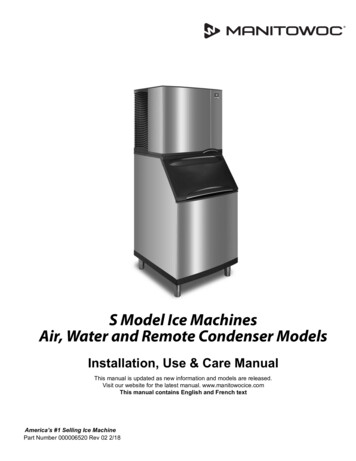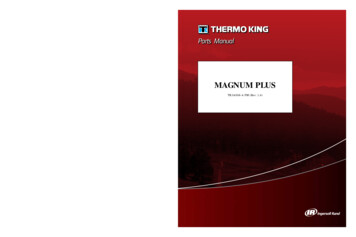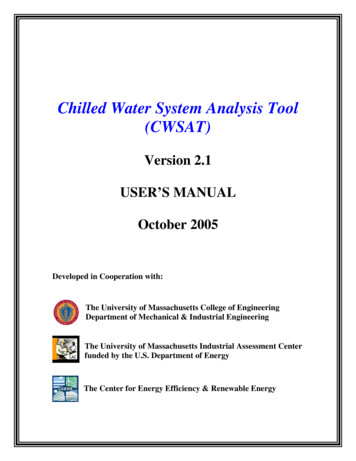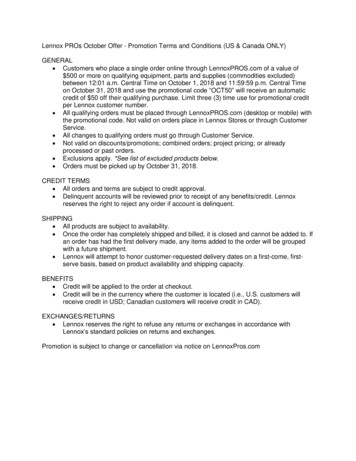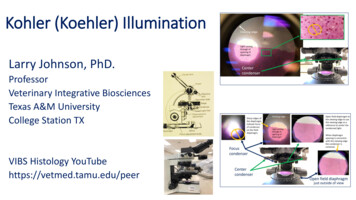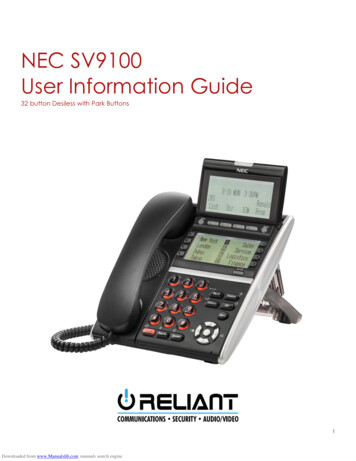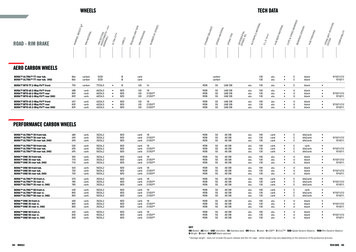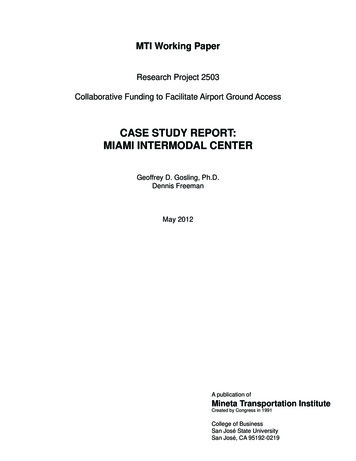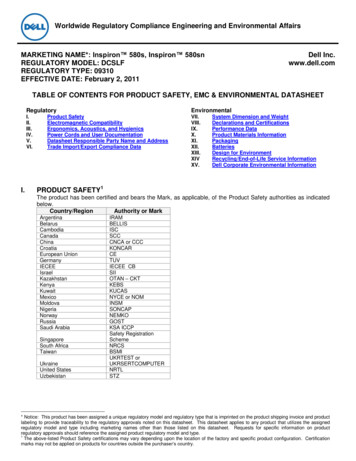
Transcription
Electret condenser mic datasheet
How to use electret condenser microphone. Difference between electret and condenser microphone. Best electret condenser microphone. Electret condenser microphone working principle. How does an electret condenser microphone work.This article will introduce you to different types of sensors and their applications. We’ll start by defining what is a sensor and sensors classification. Then we’ll discuss what are the different and possible applications for sensors. And how to choose the best sensor that fits your application or project. Finally, we’ll jump right into it and startdemonstrating each sensor one at a time. It may be a long read, but it’s definitely informative and helpful. And without further ado, let’s get started!1 What’s A Sensor?A Sensor is an electronic device that is used to measure some sort of physical parameters (e.g. temperature, pressure, light intensity, etc). The output of an electronic sensor is anelectrical signal that is either analog or digital. Processing the sensor’s output can be done in hardware (using discrete electronic elements) or in software (using some sort of microcontrollers or MPUs).Each sensor has a different working principle depending on the physical construction and the physical parameter it’s actually measuring. Thecommon thing between all sensors is they all convert a physical parameter (such as temperature) to an electric signal. But each one has a specific transfer function (for analog) or a specific communication bus as SPI, UART, etc (for digital). These specific details are demonstrated completely in the datasheet for each sensor with the typical connectiondiagram and how to interface it.2 Sensors ClassificationThere are, in fact, many classifications for sensors. We can classify sensors depending on the type of output signal or the physical parameters they measure and other considerations could be taken resulting in a variety of ways to classify sensors. However, in this article, I’ll mention a couple ofways to classify sensors. First of which is the type of output signal and the second one is the physical parameter they measure.2.1 Sensor’s Output Signals ClassificationAnalog OutputDigital OutputThe output of these sensors is an analog voltage that you can measure then determine the desired physical parameter using the sensor’s transfer function.It may also be capacitive or resistive or anything analog.The output of these sensors is digital data that you can read via serial or parallel communication buses (as UART, SPI, I2C, etc). The typical format for the data is demonstrated exactly in the sensor’s datasheet.Example: The temperature sensor (specifically LM35) is an analog sensor whoseoutputExample: The accelerometer sensor (ADXL345) is a digital sensor that sends out its output data via the I2C two-wire bus.2.2 Sensor’s Physical Parameter ClassificationThere are sensors to measure everything you can possibly think of and here is a table for the most common ones.Temperature SensorsChemical SensorsProximity SensorsTouchSensorsLight SensorsTilt SensorMetal DetectorsCamerasHumidity SensorVibration SensorMagnetic SensorColor SensorCurrent SensorPressure SensorFingerprint SensorGPSMotor Speed SensorBending SensorPIR SensorPosition SensorLidar SensorUltrasonic SensorGyroscope SensorAccelerometer SensorDigital Compass SensorSound Sensor(Mic.)IR SensorOdometer SensorAnd Much More Sensors As Well. These Are enough for the scope of this article!3 Applications For SensorsSensors have been around since the early days of electricity and have been in use in a very wide range of applications. We use sensors in electronics projects, robotics, industry, and much more. Down below is abrief list of typical applications of sensors.AutomationRoboticsEmbedded SystemsComputersSmart CarsAvionicsSatellitesSmart HomesSmartphonesSmart WatchesEnergy plantsRemote SensingCommunicationsetc.Almost in all embedded systems and electronic devices, there will be at least a couple of sensors providing some sort of feedback for aphysical property like temperature, pressure, etc. The list goes on, and it’s not in the scope of this article to create an exhaustive full list for all possible applications of sensors. It’s just meant to give you an idea of as many possibilities as I can.4 How To Choose The Right Sensor?There are many factors to consider while choosing a sensor for yourproject. But all starts by selecting the physical parameter you’re willing to measure. Then it’s the time to consider some other factors to get the best sensors for best results and within the given constraints such as budget, accuracy, etc. Down below are some of the most important factors to consider.4.1 Range of OperationThe most important factorto consider in a sensor is the operating range. If you’re designing a boiler system that will control some liquid boiling at 500 c, You shouldn’t use a small LM35 sensor that can only read up to 150 c. You should make sure that the sensor meets the range requirement of your application in order to get the right sensor for it.4.2 Accuracy(Resolution)Decide on the required resolution (accuracy) of the sensor your applications need prior to choosing a sensor. For example, a temperature sensor with an accuracy of 1 c will be sufficient for a boiler embedded system’s design. However, the same sensor with the same accuracy may not be sufficient for some critical scientific experimentsor devices that require an accuracy of 0.1 c. So, there is a trade-off and you have to make your own decision based on your system’s specifications.4.3 Total CostElectronic sensors range widely in price. You can easily guess that high accuracy sensors are always way more expensive than low accuracy ones. The operating wide dynamic rage also playsa role in determining the price point of the sensor, etc. The point is you have to make sure that you choose the sensor that gives you the best results within the allowed budget for the projects. Yes, you may drop out the resolution and still get a decent project with a small error in the output but at least it’s working! instead of burning all the budget fora high-end high-tech sensor with no money left for other parts. That’s the point of it, and again you will have to decide on these trade-offs given the exact situation and application specifications for your project.4.4 Interfacing MethodAs we’ve stated earlier, some sensors are analog and others are digital. Hence, there are different ways to interfaceand read these sensors using analog input pins of an MCU. Or connect it on a serial bus like UART, SPI, or I2C. You should also decide on the type of interface that your application can handle much more smoothly without problems or running out of serial ports.4.5 Data Rate (For Digital Sensors)Digital sensors can send you readings (data) at a ratewe call the sampling rate. Typically sensors’ rate is defined by ksp/s (kilo samples per second) which is a thousand sample points (readings) in a second. Some sensors can supply up to a few Msp/s. Most of the time, it’s a programmable feature in sensor modules. And you have to check whether this rate of data supplies your MCU with the information
it needs to run the algorithm or perform the required calculations flawlessly.4.6 DocumentationGood documentation is key whether to choose a sensor or not. Of course, you don’t want to et a sensor that has only a couple of Chinese papers describing nothing useful on how to use this crappy sensor even if it’s very cheap!Check the datasheet beforegetting a sensor and make sure it’s very clear and has the information you need to hook it up and run it on your system. Most of the quality sensors come with a very clear concise datasheet having all specifications and parameters. With connection diagrams, mode of operation, and maybe some code snippets to test it out!5 How To Get The BestSensors Collection?I highly recommend the following kit which consists of 37 different sensors modules that are easily interfaced with Arduino boards and other microcontroller-based systems. In this way you can get a hand-on experience and do some experiments with different sensors, so you may in the future create a sensor-based application. Thiskit is available on Amazon.com and you’ll find Arduino sketches everywhere on the internet in order to get started with each of these sensors.Different Types of SensorsTemperature SensorsSemiconductor Temperature Sensors are the devices that come in the form of integrated circuits i.e. ICs hence, popularly known as IC temperature sensors.These are the electronic devices manufactured in an identical fashion to present-day electronic semiconductor devices like microprocessors. More than thousands of devices can be fabricated upon thin silicon wafers. A whole new range of semiconductor temperature sensors is arriving from different manufacturers. However, the most popular onesinclude AD590 and LM35.Their design results from the fact that semiconductor diodes have temperature-sensitive voltage vs. current characteristics. When two identical transistors are operated at a constant ratio of collector current densities, the difference in base-emitter voltages is directly proportional to the absolute temperature.NegativeTemperature Coefficient (NTC) thermistor. The effective operating range is -50 to 250 C.Resistance Temperature Detector (RTD), also known as a resistance thermometer. Platinum RTDs offer a fairly linear output that is highly accurate (0.1 to 1 C) across -200 to 600 C. While providing the greatest accuracy, RTDs also tend to be the mostexpensive of temperature sensors.Thermocouple. A thermocouple is an electrical device consisting of two dissimilar electrical conductors forming electrical junctions at differing temperatures. A thermocouple produces a temperature-dependent voltage as a result of the thermoelectric effect, and this voltage can be interpreted to measuretemperature. Thermocouples are a widely used type of temperature sensor.Thermocouples are nonlinear sensors, requiring conversion when used for temperature control and compensation, typically accomplished using a LUT (lookup table). Accuracy is low, from 0.5 C to 5 C. However, they operate across the widest temperature range, from -200 C to 1750 C.Pressure SensorsPressure sensors are used for measuring the pressure of gases and liquids. Pressure sensors are used for control and monitoring in thousands of everyday applications. Pressure sensors can also be used to indirectly measure other variables such as fluid/gas flow, speed, water level, and altitude.Different Types OfPressure SensorsPressure sensors can be classified in terms of pressure ranges they measure temperature ranges of operation, and most importantly the type of pressure they measure. Pressure sensors are variously named according to their purpose, but the same technology may be used under different names.1 Absolute pressure sensorThis sensormeasures the pressure relative to a perfect vacuum.2 Gauge pressure sensorThis sensor measures the pressure relative to atmospheric pressure. A tire pressure gauge is an example of gauge pressure measurement; when it indicates zero, then the pressure it is measuring is the same as the ambient pressure.3 Vacuum pressure sensorThis term cancause confusion. It may be used to describe a sensor that measures pressures below atmospheric pressure, showing the difference between low-pressure and atmospheric pressure, but it may also be used to describe a sensor that measures absolute pressure relative to a vacuum.4 Differential pressure sensorThis sensor measures the differencebetween two pressures, one connected to each side of the sensor. Differential pressure sensors are used to measure many properties, such as pressure drops across oil filters or air filters, fluid levels (by comparing the pressure above and below the liquid), or flow rates (by measuring the change in pressure across a restriction). Technically speaking,most pressure sensors are really differential pressure sensors; for example, a gauge pressure sensor is merely a differential pressure sensor in which one side is open to the ambient atmosphere.Chemical SensorsA chemical sensor is a self-contained analytical device that can provide information about the chemical composition of its environment, thatis, a liquid or a gas phase. The information is provided in the form of a measurable physical signal that is correlated with the concentration of a certain chemical species. Chemical sensors include the gas sensor, methane sensor, hydrogen sensor, Carbon dioxide sensor, etc.Chemical sensors are widely used in biomedical sensing and diagnosingdevices. This type of sensors is used for the diagnostics of gaseous issues such as the concentration of chemicals in human bodies. The monitoring purposes of chemical activities in the body are measured by chemical sensors. The high chemical sensitivity of graphene enables it to be the most desirable component in biomedical devices.Here are someexamples of chemical sensors modules that you can get and connect to your microcontroller-based system maybe Arduino or whatever.Gas SensorCarbon Dioxide SensorAlcohol SensorMethane SensorHumidity SensorThe definition of humidity asserts that it’s the percentage of H2O presence in the atmosphere (air), it’s the amount of water vaporexisting in the air of a specific area. Humidity measurement in industries is critical because it may affect the business cost of the product and the health and safety of the personnel. Hence, humidity sensing is very important, especially in the control systems for industrial processes and human comfort.Humidity also can affect and damage metallicequipment by accelerating the chemical corrosion process. In these areas, high humidity is not desirable at all. However, in some applications like farming the humidity is a good thing for several plants and hence it could be actually a good thing.The most common module for humidity sensing the DT11 (on Amazon.com) You can hook it to yourArduino and make a DIY humidity sensing station in a few minutes. And of course, you can use it in many other projects where you need to measure the percentage of air humidity level.Current SensorsA current sensor is an electronic device that can detect electric current DC or AC in a wire, and generates a signal proportional to that current. Thegenerated signal could be analog voltage or current or even a digital output. The generated signal can be then used to display the measured current in an ammeter, or can be stored for further analysis in a data acquisition system, or can be used for the purpose of control.We typically use current sensors to determine the power consumption in loads,or maybe estimate the torque in DC motors. There are actually endless possibilities for current sensors applications. You can easily interface this sensor with any microcontroller for sure. Here is a picture of the most common current sensor module in the makers’ space.Hall effect current sensors consist of a core, Hall effect device, and signalconditioning circuitry. The sensor works when the current conductor passes through a magnetically permeable core that concentrates the conductor’s magnetic field. The Hall effect sensor, which is mounted within the core, is at a right angle to the concentrated magnetic field and a constant current (in one plane) excites the Hall sensor. Theenergized Hall sensor is then exposed to a magnetic field from the core and it produces a potential difference that can be measured and amplified for further processing and monitoring by any microcontroller.Hall Effect Current SensorVibration SensorThere are typically three different types of sensors that are being used in vibration detection:displacement, velocity, and acceleration. Displacement sensors measure changes in distance between a machine’s rotating element and its stationary housing (frame). Displacement sensors come in the form of a probe that threads into a hole drilled and tapped in the machine’s frame, just above the surface of a rotating shaft. Velocity and accelerationsensors, by contrast, measure the velocity or acceleration of whatever element the sensor is attached to, which is usually some external part of the machine frame.There are many applications that you can design and make using the vibration sensor and it ranges from small wearables to HVAC systems, other examples include: Automotive industrialapplications and motor control and monitoring systems.Vibration sensing could be also useful for robotics especially mobile robots. You can tell if your robot did crash into something or whether it’s moving over a smooth or rough road. There are many possibilities and different ways to make use of the vibration sensor in your projects.Vibration SensorModuleSound SensorsThere are many applications where you need to make your system sound-aware. Maybe respond to some sort of sound signals or voice commands or whatever. There are many types of sound sensing devices, in this article, I’ll highlight a couple of them. First of which is the microphones which are the most common devices topick up sound waves and turns it into an electric signal. And the second type is the piezoelectric elements that also converts the pressure into small electric signals. The sound travels through the air as a wave of pressure and that’s exactly what causes the piezoelectric elements to generate a simial wave but in the form of an electricsignal.MicrophonesA microphone is the most common sound sensor in the world. It does exist in our smartphones, laptops, and all sound systems whether it’s embedded or standalone. A typical microphone transforms the sound waves into electric signals that could be amplified or sent to a DSP (digital signal processor) for further processing oranalysis. There are different types of microphone depending on the construction and the working principle of it.An electret microphone is a type of electrostatic capacitor-based microphone, which eliminates the need for a polarizing power supply by using a permanently charged material. An electret is a stable dielectric material with a permanentlyembedded static electric dipole moment (which, due to the high resistance and chemical stability of the material, will not decay for hundreds of years). The name comes from electrostatic and magnet; drawing the analogy to the formation of a magnet by the alignment of magnetic domains in a piece of iron.Electret MicrophoneCondenserMicrophonePiezoelectric ElementsA piezoelectric sensor is a device that uses the piezoelectric effect, to measure changes in pressure, acceleration, temperature, strain, or force by converting them to an electrical charge. Piezoelectric sensors are versatile tools for the measurement of various processes. They are used for quality assurance, processcontrol, and for research and development in many industries.They have been successfully used in various applications, such as in medical, aerospace, nuclear instrumentation, and as a tilt sensor in consumer electronics or a pressure sensor in the touchpads of mobile phones. In the automotive industry, piezoelectric elements are used to monitorcombustion when developing internal combustion engines.One disadvantage of piezoelectric sensors is that they cannot be used for truly static measurements. A static force results in a fixed amount of charge on the piezoelectric material. In conventional readout electronics, imperfect insulating materials and reduction in internal sensor resistancecause a constant loss of electrons and yields a decreasing signal. Elevated temperatures cause an additional drop in internal resistance and sensitivity. The main effect on the piezoelectric effect is that with increasing pressure loads and temperature, the sensitivity reduces due to twin formation.ApplicationsThere are many different applications forsound sensors and microphones, here is a brief list for some applications that depend on sound sensors.Microphones are used in many applications such as telephones, hearing aids, public address systems for concert halls and public events, motion picture production, live and recorded audio engineering, sound recording, two-way radios,megaphones, radio and television broadcasting, and in computers for recording voice, speech recognition, VoIP, and for non-acoustic purposes such as ultrasonic sensors or knock sensors. Another interesting application is voice recognition which you can easily implement using this module (on Amazon.com) That off-loads the voice processing andrecognition task from the main controller giving you more CPU time and flexibility.Magnetic SensorMagnetic sensors are designed and used to detect the magnetic field strength due to the existence of magnets. There are different types of and shapes for magnetic sensors. Some of which are designed to work in contactless applications such as doorclose indicators. Other types use the hall effect sensing to remotely sense the strength of the magnetic field.Magnetic sensors are often used for security and military applications such as detection, discrimination, and localization of ferromagnetic and conducting objects, navigation, position tracking, and antitheft systems. There are so manyapplications that you can create or build using this type of sensors. Just do your research before choosing the right one for your purpose.Light SensorLight sensors are the type of sensors that can detect the light intensity in the surrounding environment. There are many types of light sensors depending on the principle of operation and the type oflight energy it can detect (ambient light, IR, laser, etc). In this article, I’ll mention a couple of light sensors, the LDR (light dependent resistance) and the photoconductive cell.LDRA photoresistor (or light-dependent resistor, LDR, or photo-conductive cell) is a light-controlled variable resistor. The resistance of a photoresistor decreases with increasingincident light intensity. In other words, it exhibits photoconductivity. A photoresistor can be applied in light-sensitive detector circuits and light-activated and dark-activated switching circuits.A photoresistor is made of a high resistance semiconductor. In the dark, a photoresistor can have a resistance as high as several megohms (MΩ), while in thelight, a photoresistor can have a resistance as low as a few hundred ohms. If incident light on a photoresistor exceeds a certain frequency, photons absorbed by the semiconductor give bound electrons enough energy to jump into the conduction band. The resulting free electrons (and their hole partners) conduct electricity, thereby loweringresistance.PhotoDetectorPhotodetectors, also called photosensors, are sensors of light or other electromagnetic radiation. A photo-detector has a p–n junction that converts light photons into a current. The absorbed photons make electron-hole pairs in the depletion region. Photodiodes and photo-transistors are a few examples of photo-detectors.Solar cells convert some of the light energy absorbed into electrical energy.Color SensorThe color of an object we see in fact is the chromatic light the object reflects in the white light after it absorbs the rest colors. The white color is a mixture of various visible colors, which means it includes each colored light like red (R), green (G), blue (B). Basedon the theory of three primary colors, any color is made by mixing the three primary colors (red, green, and blue) in a certain proportion. Thus, knowing the proportion you can get the color of the tested object.A color sensor does expose the opposing object to white light then it absorbs back the reflected light from the object. This reflected light ispassed through filters for red, green, and blue. Then the light intensity of each color is easily found and the sensor outputs these signals to the microcontroller so you can determine the color of an object with your Arduino-based application or any other microcontroller. An example of a color sensor is the TCS3200 like the one in the picturebelow.Color sensors are generally used for two specific applications: true color recognition and color mark detection. Sensors used for true color recognition are required to “see” different colors or to distinguish between shades of a specific color. They can be used in either a sorting or matching mode. In sorting mode, the output is activated whenthe object to be identified is close to the set color. In matching mode, the output is activated when the object to be detected is identical (within tolerance) to the color stored in memory. Color mark detection sensors do not detect the color of the mark, rather, they “see” differences or changes in the mark in contrast with other marks or backgrounds.They are sometimes referred to as contrast sensors.GPSGlobal Positioning System (GPS) is a satellite-based radio-navigation system owned by the United States government and operated by the United States Air Force. It is a global navigation satellite system (GNSS) that provides geolocation and time information to a GPS receiver anywhere on ornear the Earth where there is an unobstructed line of sight to four or more GPS satellites. Obstacles such as mountains and buildings block the relatively weak GPS signals.The GPS concept is based on time and the known position of GPS specialized satellites. The satellites carry very stable atomic clocks that are synchronized with one another andwith the ground clocks. Any drift from true time maintained on the ground is corrected daily. In the same manner, the satellite locations are known with great precision. GPS receivers have clocks as well, but they are less stable and less precise.The GPS does not require the user to transmit any data, and it operates independently of any telephonic orinternet reception, though these technologies can enhance the usefulness of the GPS positioning information. The GPS provides critical positioning capabilities to military, civil, and commercial users around the world. The United States government created the system, maintains it, and makes it freely accessible to anyone with a GPS receiver.Thereare dozens and dozens of applications that utilize GPS technology. You can use this module in different ways in order to achieve the design goal of your system. Here are some of the very common applications for GPS.Solo TravelingLocating Your PetMapping & SurveyingLocating PositionsPreventing Car TheftDrones Stabilization and HoldPositionAnd Much More Accelerometer SensorAccelerometers are electronic sensors that measure acceleration, which is the rate of change of the velocity of an object. They measure in meters per second squared (m/s2) or in G-forces (g). A single G-force for us here on planet Earth is equivalent to 9.8 m/s2, but this does vary slightly with elevation(and will be a different value on different planets due to variations in gravitational pull). Accelerometers are useful for sensing vibrations in systems or for orientation applications.Accelerometers can measure acceleration on one, two, or three axes. 3-axis units are becoming more common as the cost of development for them decreases. Generally,accelerometers contain capacitive plates internally. Some of these are fixed, while others are attached to minuscule springs that move internally as acceleration forces act upon the sensor. As these plates move in relation to each other, the capacitance between them changes. From these changes in capacitance, the acceleration can bedetermined.Different ApplicationsAccelerometers can be used to measure vehicle acceleration. Accelerometers can be used to measure vibration on cars, machines, buildings, process control systems, and safety installations. They can also be used to measure seismic activity, inclination, machine vibration, dynamic distance and speed with or withoutthe influence of gravity. Applications for accelerometers that measure gravity, wherein an accelerometer is specifically configured for use in gravimetry, are called gravimeters. Camcorders use accelerometers for image stabilization, either by moving optical elements to adjust the light path to the sensor to cancel out unintended motions or digitallyshifting the image to smooth out detected motion. Some stills cameras use accelerometers for anti-blur capturing. The camera holds off capturing the image when the camera is moving. When the camera is still (if only for a millisecond, as could be the case for vibration), the image is captured.Gyroscope SensorGyroscope sensors, also known asangular rate sensors or angular velocity sensors, are devices that sense angular velocity. The angular velocity is the change in the rotational angle per unit of time. Angular velocity is generally expressed in deg/s (degrees per second).Applications of gyroscopes include inertial navigation systems, such as in the Hubble Telescope, or inside the steelhull of a submerged submarine. Due to their precision, gyroscopes are also used to maintain direction in tunnel mining. Gyroscopes can be used to construct gyrocompasses, which complement or replace magnetic compasses (in ships, aircraft, and spacecraft, vehicles in general), to assist in stability (bicycles, motorcycles, and ships) or be used aspart of an inertial guidance system. MEMS gyroscopes are popular in some consumer electronics, such as smartphones. MEMS gyroscopes are used in automotive roll-over prevention and airbag systems, image stabilization, and have many other potential applications.Inexpensive vibrating structure microelectromechanical systems (MEMS)gyroscopes have become widely available. These are packaged similarly to other integrated circuits and may provide either analog or digital outputs. In many cases, a single part includes gyroscopic sensors for multiple axes. Some parts incorporate multiple gyroscopes and accelerometers (or multiple-axis gyroscopes and acce
How to use electret condenser microphone. Difference between electret and condenser microphone. Best electret condenser microphone. Electret condenser microphone working principle.

